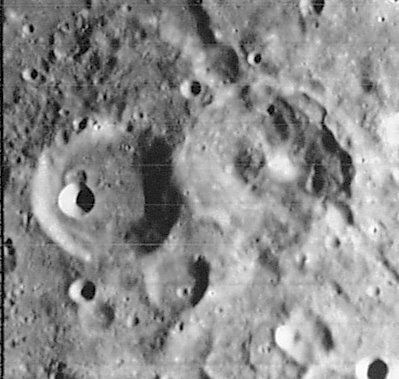Isidorus
Contents
[hide]Isidorus
|
Lat: 8.0°S, Long: 33.5°E, Diam: 42 km, Depth: 3.33 km, Rükl: 47 |

LOIV 072 H3
Isidorus is on the left, Capella is on the right.
Images
LPOD Photo Gallery Lunar Orbiter Images Apollo Images
- Certain regions on the moon's surface don't look quite "lunar like", such as the high albedo streamers on the inner slopes of satellite crater Isidorus D. One such bright streamer, at LON: 34.13, LAT: -4.34, is worthwile to investigate on the LRO's ACT-REACT Quick Map. - DannyCaes Jun 18, 2011
Maps
(LAC zone 79D1) LAC map Geologic map LTO map
Description
Description: Elger
(IAU Directions) ISODORUS.--The rampart of this fine ring-plain, which is of about the same size as Capella, rises at a peak on the E. to a height of more than 13,000 feet above the interior, which, except a small bright crater at the foot of the W. wall and a smaller one adjoining it on the N., contains no detail. The region between Isodorus and the equator includes many interesting objects, among them Isodorus b, an irregular formation open towards the N., and containing several craters.
Description: Wikipedia
Additional Information
- Depth data from Kurt Fisher database
Pike, 1976: 3.33 km
Arthur, 1974: 3.81 km
Westfall, 2000: 2.5 km
Viscardy, 1985: 1.58 km - Satellite craters Isidorus A and U are on the ALPO list of bright ray craters
- Satellite craters Isidorus D and E are on the ALPO list of banded craters
- Isidorus A & D are thermal anomaly craters, implying youthful ages - Moore et al, 1980
Nomenclature
Saint Isidore of Seville (c. 560 – April 4, 636) was a Spanish astronomer and encyclopaedist. He was Archbishop of Seville for more than three decades and has the reputation of being one of the great scholars of the early Middle Ages. Isidore taught that the Earth was round. His meaning was ambiguous and some writers think he referred to a disc-shaped Earth; his other writings make it clear, however, that he considered the Earth to be globular.
LPOD Articles
Bibliography
Isidorus D: APOLLO OVER THE MOON; A VIEW FROM ORBIT, Chapter 5: Craters (Part 2), Figure 119.
Apollo Image Archive Image of the Week